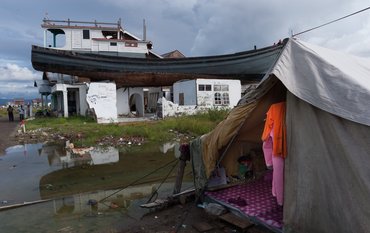Summary
Life can exist even in extreme environments such as the Atacama Desert, one of the driest regions on Earth. However, studying this life is challenging due to the relatively low abundance of microorganisms available for study. A team from the German Research Centre for Geosciences (GFZ), led by Dr Alexander Bartholomäus, Dr Steffi Genderjahn, and Prof. Dirk Wagner, in collaboration with international partners, has now demonstrated that a new genetic technique allows for detailed analysis of these unique life forms. This method is based on separating the DNA of living and dead organisms.
The team’s findings show that the desert hosts an astonishing variety of specialized microorganisms. The study, published in Applied and Environmental Microbiology, helps expand our knowledge of microorganisms and processes such as soil formation and microbially driven weathering, and improves our understanding of extreme habitats with low biomass.
Background: The Atacama Desert as one of the most extreme habitats
The Atacama Desert in Chile is one of the driest and oldest deserts on Earth. The annual rainfall is only two millimetres, with rain occurring mainly in El Niño years, roughly once every decade. Additionally, the soils are highly saline and rich in minerals that have accumulated over time. Daily temperature fluctuations (0°C - 32°C), UV radiation on the surface, and the low organic carbon content in the soil also make it one of the most extreme environments in the world.
All these conditions make life in the desert extraordinarily harsh and virtually inhospitable. Nevertheless, other studies have shown that a variety of microorganisms have adapted to these conditions. However, accurately identifying and studying these life forms using traditional DNA or RNA extraction methods often fails, especially in extreme habitats. RNA-based methods, which examine microbial activity, are often not feasible due to low biomass.
New method for analysing microorganisms under extreme conditions: separation of the eDNA- and iDNA pool
The research team, led by Dr Alexander Bartholomäus (Head of Bioinformatics at GFZ's “Geomicrobiology” section), Dr Steffi Genderjahn (former team member), and Prof. Dirk Wagner (Head of the “Geomicrobiology” section), applied a new DNA analysis method for their study, developed in part in Wagner’s lab. This method separates the DNA into extracellular DNA (eDNA, from dead cells) and intracellular DNA (iDNA, from living cells). This enables separate analysis of both living and potentially active microorganisms as well as dead ones. The result is a more accurate picture of the truly active life forms, even in environments where other methods might fail.
Study of multiple locations with different soil moisture using the new DNA analysis approch
The team investigated six sites along a moisture gradient, from the coast to some of the driest locations in the Atacama. They collected soil samples from the surface and from depths of 20-30 centimetres for comparison. The DNA was extracted using the new method for separating eDNA and iDNA. Specific genes, such as the 16S rRNA gene, were amplified using PCR-based techniques and analysed bioinformatically.
As expected, the samples from the wetter sites showed a large overlap in the detected organisms. These sites are more favourable for life due to the higher moisture content, leading to more microbial activity and greater nutrient turnover. Simply put, the more active a community, the more similar the eDNA (dead) and iDNA (living) pools are. In contrast, some extreme sites showed much smaller overlaps between the eDNA and iDNA pools. In some cases, only 13% of microorganisms shared the pools. This highlights the advantage of the method used, as traditional DNA-based analyses might have led to incorrect conclusions here.
Identification of diverse life forms even under the most extreme conditions
The team successfully identified living microorganisms that have adapted to the extreme conditions and carry out crucial functions for the desert ecosystem, such as carbon and nitrogen fixation. “With the new method, we are able to gain insights into these extreme habitats that were not possible before. The microbes we identified play a key role in the initial soil formation processes,” explains Alexander Bartholomäus, first author of the study. “They are able to survive on minimal resources and even break down minerals, which is crucial for soil development in extreme environments.”
A closer look at the living microbial community revealed that some organisms are generalists, present at nearly all sites. Among them were Acidimicrobiia, Geodermatophilaceae, Frankiales, and Burkholderiaceae, which are known for initiating soil formation and microbial mineral weathering. On the other hand, there were many specialists that occur only at specific sites or at particular depths, with small overall populations. These specialists appear to have adapted to the locally available resources. For example, at the wetter site influenced by salt-rich coastal spray, salt-loving (halophilic) archaea were identified as specialists.
Resume and outlook
“The Atacama Desert presents enormous challenges to microbiologists due to its extreme conditions. It is fascinating to see how adaptable the microbes are, and that we now have the tools to decipher microbial life and behavior in the face of climate change,” resumes Dirk Wagner. “Further methodological refinements and new molecular techniques could enhance our understanding of low-biomass ecosystems. The new eDNA/iDNA separation method could also be applied to other extreme environments, such as the dry valleys of Antarctica or Mars-like conditions. This would help expand our understanding of microbial adaptations and survival strategies in extreme ecosystems worldwide, and by identifying life forms in Mars-like environments, contribute to astrobiology.”
Original Publication:
Bartholomäus A, Genderjahn S, Mangelsdorf K, Schneider B, Zamorano P, Kounaves SP, Schulze-Makuch D, Wagner D. 0. Inside the Atacama Desert: uncovering the living microbiome of an extreme environment. Appl Environ Microbiol 0:e01443-24.







![[Translate to English:] Fire in a forest, smoke rising, aerial view from above](/fileadmin/_processed_/8/3/csm_2025_01_06_AdobeStock_415831729_5a0e6d50d3.jpeg)









![[Translate to English:] [Translate to English:] Abror Gafurov von dem Schriftzug "Welcome to Azerbaijan" und den UN und COP Logos](/fileadmin/_processed_/2/5/csm_2024_11_Baku_COP29_Abror_Gafurov_1042faec82.jpeg)


![[Translate to English:] Martin Herold standing in front of the library on the Telegrafenberg](/fileadmin/_processed_/c/d/csm_Martin_Herold_d385ee4dd9.jpeg)
![[Translate to English:] Many people are listening to a presentation in the GFZ lecture hall.](/fileadmin/_processed_/c/a/csm_1_Bild1_hell_b9c0e9f5ed.jpeg)





![[Translate to English:] Both scientists sitting on stools in front of a wall of books in the Telegrafenberg library](/fileadmin/_processed_/6/6/csm_Buiter_Castell_DORA_4_e87cb1ea18.jpeg)
![[Translate to English:] Gruppenbild mit 4 Personen](/fileadmin/_processed_/8/d/csm_20241017_GFZ-Emmerman-Medal-005_web_reinhardtundsommer_21a414fa4a.jpeg)






![[Translate to English:] Ice landscape with five red tents](/fileadmin/_processed_/8/9/csm_Zeltlager_auf_dem_Eis_Urheberin_Jenine_McCutcheon_5ced2d523b.jpeg)
